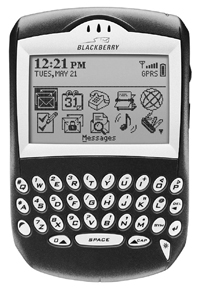How They Started (29 page)
Authors: David Lester

Wireless success
Founders:
Mike Lazaridis (shown) and Doug Fregin
Age of founders:
Both 23
Background:
Engineering students
Founded in:
1984
Headquarters:
Waterloo, Ontario, Canada
Business type:
Mobile communications

Mike Lazaridis is every inch the inventor.
Since co-founding Research In Motion (RIM), one of the most profitable device makers in history, he has earned a reputation for being a true visionary of mobile communications—with good reason. This is the man who was studying wireless technology in the late 1980s, before most people even had a home PC. The primary fruit of this research, the BlackBerry device, now enables millions of users around the world to check, send and receive emails while on the move. RIM generated revenues of more than $19.9 billion in the fiscal year ended February 2011.
Now 51, Mike is still heavily involved in one of the most successful and pioneering technology businesses in the world. It wasn’t until the first weeks of 2012 that Mike handed over day-to-day operations to RIM Chief Operating Officer Thorsten Heins, and he has stayed on as vice chair of the board, and chair of the board’s new Innovation Committee. He is as determined as ever to maintain RIM’s position as a technology pioneer.
There were signs of Mike’s inventive talents long before the world started to hear about them. The man who helped develop the world’s first reliable portable email device made a record player out of Lego blocks at the tender age of four. When he was 12, his fascination with engineering and with the way things work became clear when he was awarded a prize at his local public library in Windsor, Ontario, for reading every science book on its shelves.
Perhaps unsurprisingly, Mike’s peers remember that even as a teenager he had a seemingly endless bank of new ideas and inventions. In 1984, while studying electrical engineering at the University of Waterloo in Ontario, he set up a company with childhood friend Doug Fregin to develop some of his ideas. This company was backed by Mike’s parents and a New Ventures Loan from the government of Ontario. RIM was born.
Founded as an electronics and computer science business, RIM caught a lot of people’s attention, and Mike, certain of its potential and desperate to devote all his time and energy to it, dropped out of college just a month before graduating to work on the business full-time. It was around this time that RIM won a major $600,000 contract with General Motors, one of the largest car companies in the world, to create an electronic display system. The creation of user-friendly electronic displays has since proved to be a particular strength for Mike, as evidenced in the BlackBerry.
After his first big project with General Motors, a series of successive contracts generated revenue for RIM, and by the late 1980s sales hit $1 million, with the company having grown to employ 12 people. In 1987, a contract with Rogers Cantel Mobile Communications Inc., a mobile phone and pager operator, marked the beginning of the company’s journey into wireless communications. RIM was the first wireless data technology developer in North America. Tasked with researching digital wireless devices, RIM developed a wireless radio modem. It was later used in products such as computers and vending machines, and for business communications such as credit card transactions.
Throughout the 1990s, RIM focused its energy on the challenge of making mobile wireless emailing a reality. The company began working with Ericsson to enable its wireless data network to support two-way paging and wireless email, as part of a three-way partnership with Anterior Technology. In 1992, Mike hired James Balsillie to develop and run the business, freeing him up to focus on what he does best: engineering. Harvard MBA graduate Balsillie soon became RIM’s chairman and co-chief executive.
Balsillie invested CA$250,000 into the business himself and later helped secure CA$2 million from COM DEV, a technology firm in Waterloo, Ontario. The company also received CA$100,000 from the University of Waterloo’s Industrial Research Assistance Program in 1994. Further research and development was funded by venture capitalists who invested in the company in 1995. In the first round of venture capital funding, Working Ventures Canadian Fund made a CA$5 million investment, which was used to complete the development of RIM’s wireless hardware and software. During this time, RIM also received substantial investment in the form of loans and grants from the Canadian Government.
RIM was the first wireless data technology developer in North America.
In 1996, RIM developed a plug-in card for computer-enabled wireless email. By the following year, the company had created a relatively small handheld device that for the first time enabled two-way messaging via a pager (using BellSouth’s wireless data network). Named the Inter@ctive pager, it was soon snapped up by companies including IBM and Panasonic, which distributed the devices to their field staff.
Realizing the potential of their wireless email technology, and knowing just how much money it would take to pursue these opportunities, Balsillie and Mike knew they needed a substantial amount of extra capital. So RIM decided to go public. The company raised CA$115 million when it listed on the Toronto Stock Exchange in 1997, a further $250 million when it floated on NASDAQ in 1999, and yet another $900 million from a share issue in November 2000.
The first BlackBerry was launched in 1999. This device made it possible for users to access their corporate email accounts (from a Microsoft exchange server) while on the move. Its “always-on” technology was an instant hit with customers, who were alerted when they received a new email and didn’t have to go in and retrieve it. It cost $399, with a monthly subscription charge of $39.99. By 2000, the BlackBerry was named Product of the Year by the online magazine InfoWorld.

An early model: the Blackberry 6210.
The brand was soon a commercial triumph. In 1999, sales of the BlackBerry more than doubled RIM’s revenue to $47.5 million, while profits rose to $6.8 million. Central to BlackBerry’s success were RIM’s partnerships with the big ISPs, telecommunications companies and, later, the mobile phone networks, to allow those companies to offer BlackBerry devices and fee plans. By the end of 1999, several major ISPs, including RCN Corporation and GoAmerica Communications corp in the US, had signed up to offer BlackBerry’s services to their customers. Overseas, Telcel Cellular was offering two-way messaging through RIM’s interactive pager across Latin America.
Its “always-on” technology was an instant hit with customers, who were alerted when they received a new email and didn’t have to go in and retrieve it.
RIM also negotiated distribution agreements with huge computer companies such as Dell and Compaq, whereby the computer companies’ sales staff would sell the BlackBerry to their large corporate clients. In addition to increasing sales and profits quickly, this helped raise BlackBerry’s profile. As early as the first year after its release, the devices started to crop up in business meetings, especially among investment bankers and venture capitalists, who thrive on being as up-to-date as possible.
As a result, sales of BlackBerry devices took off in the US corporate market. In 2000, the Canadian telecommunications company Nortel invested $25 million in RIM as part of a joint marketing and product development agreement with a view to extending BlackBerry’s global reach. By the end of the year, revenue had grown to $85 million, with net income of $10.2 million.
RIM was far from alone in its development of devices to access email remotely. By the late 1990s, email had become so central to most people’s work in the developed world that remote access to email was clearly going to be an enormous market. The first company to crack it would surely make billions in profit. Unsurprisingly, there was lots of competition, including Microsoft and Palm Inc. The latter had done well with its personal digital assistant (PDA) that featured a pen rather than a keyboard. BlackBerry took off because it came up with a way for people to access their email easily and quickly on a small device. Operating systems such as Windows work very well but are very large, which makes them relatively slow on small computers. RIM’s genius was to work well with Windows but use its own operating system, one that could be optimized for small devices and work much faster than Microsoft’s equivalent.
In addition to this, BlackBerry did two other things that were unconventional yet worked brilliantly. The first was to offer a QWERTY keyboard that was large enough to be easy to use. The second was to use a “flywheel” to move between emails and around the screen. This worked extremely fast, and people learned how to use it in literally a few seconds. Within minutes of having their BlackBerrys set up, people were comfortable using them, unlike most other competitive devices trying to do the same thing.
By 2001 the BlackBerry, which now had its signature thumb-controlled keyboard, was beginning to make an impression on the European market. Agreements with telecommunications companies such as BT Cellnet, Digifone and Telfort Mobiel meant BlackBerry devices became available in the UK, Ireland and the Netherlands, respectively. Meanwhile, expansion in the home market continued at a fast pace, helped along by more distribution agreements with the likes of IBM. By the end of 2001, more than 12,000 organizations in North America were using BlackBerrys.
Within minutes of having their BlackBerrys set up, people were comfortable using them, unlike most other competitive devices trying to do the same thing.

RIM’s head office in Waterloo, Ontario, Canada.
By this point, RIM had sold over 200,000 devices and had forged a partnership with AOL to provide its email service through RIM’s handheld devices. While Palm’s range of PDAs were the biggest sellers in the overall market, the BlackBerry was fast becoming the device of choice for business people who needed fast and reliable access to their corporate emails.
The early years of the new century brought stiff competition, not least the introduction of Nokia’s SMS service. To remain competitive, RIM in 2002 began enabling third-party developers and manufacturers to enhance their products and services with wireless communications. It also began licensing its keyboard technology (which was uniquely controlled by a user’s thumb) to its rivals Palm and Handspring.
A decision to partner with Hutchison—one of Australia’s biggest media technology companies, which operates the mobile phone brand 3G—signaled the arrival of the BlackBerry “down under.” Hutchison Telecoms offers an industry-leading international roaming service that operates in over 149 countries. In 2001, Hutchison was beginning to expand outside its native Australia and promoted the BlackBerry device heavily throughout Asia and the Antipodes.